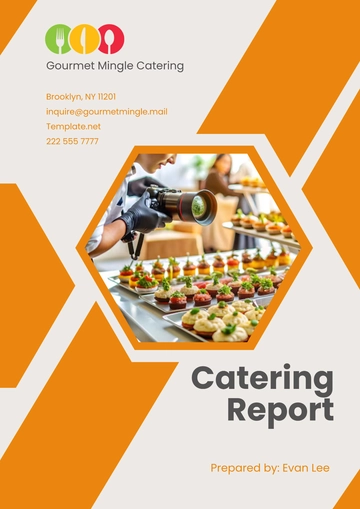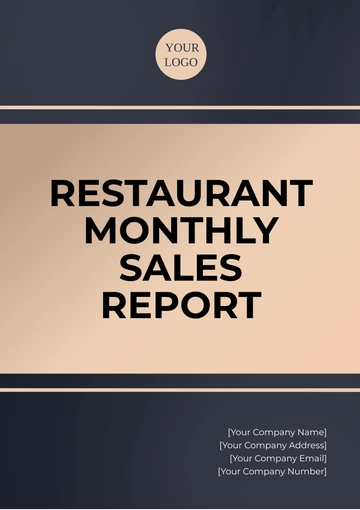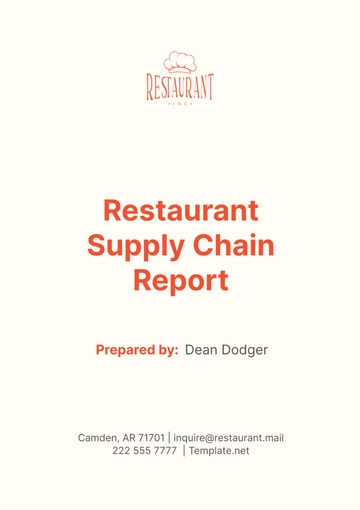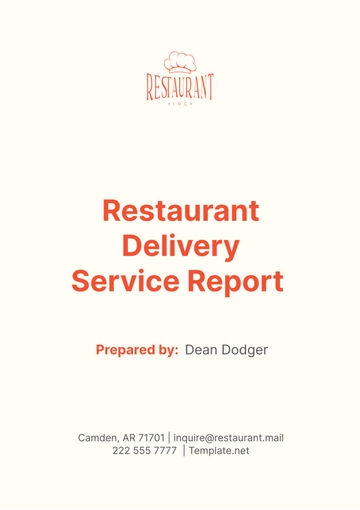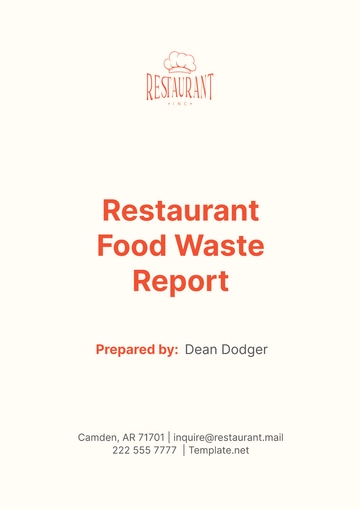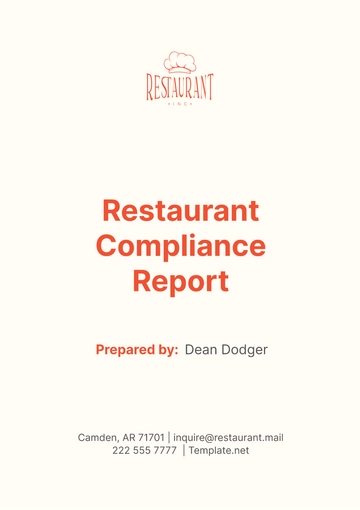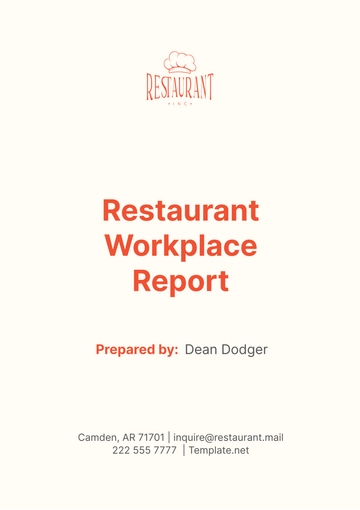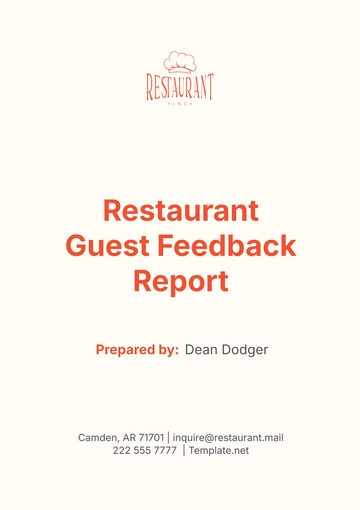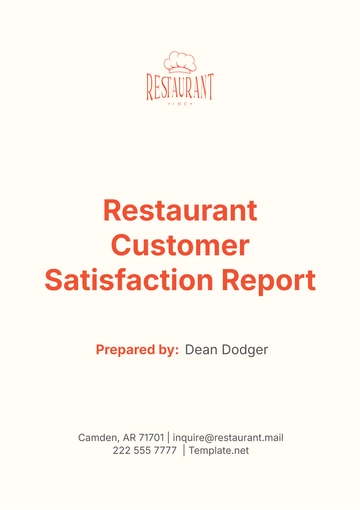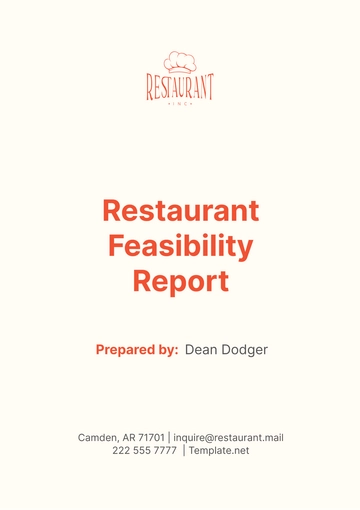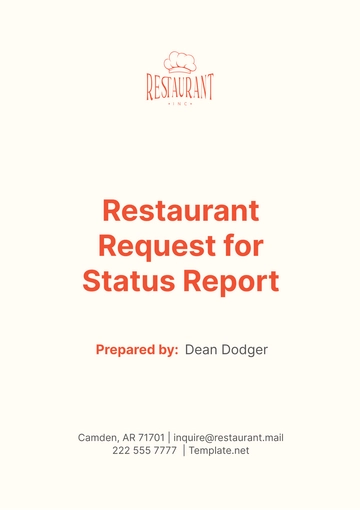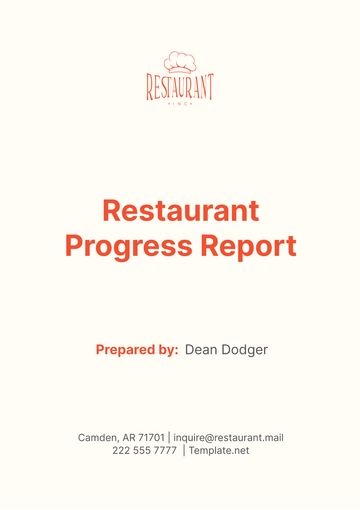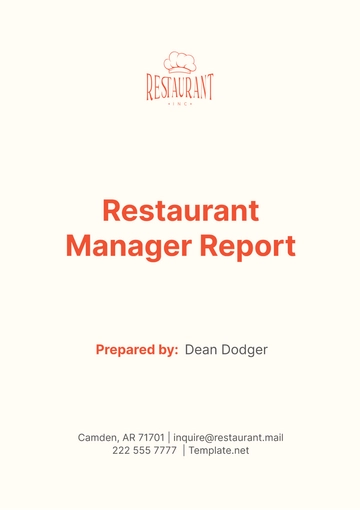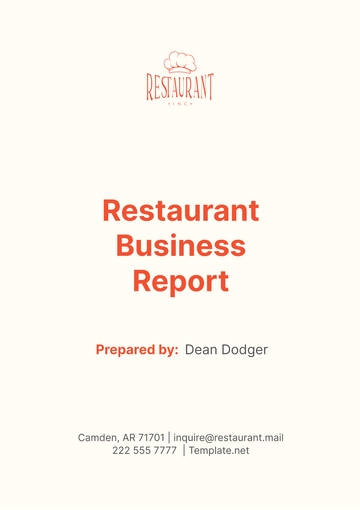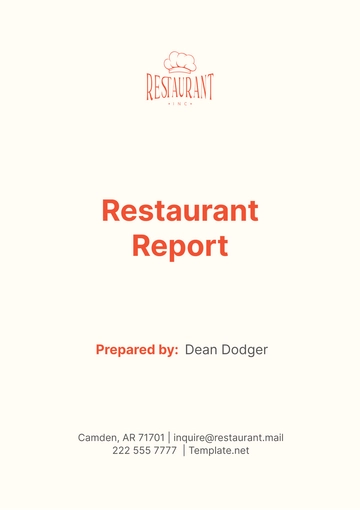Free Restaurant Progress Report
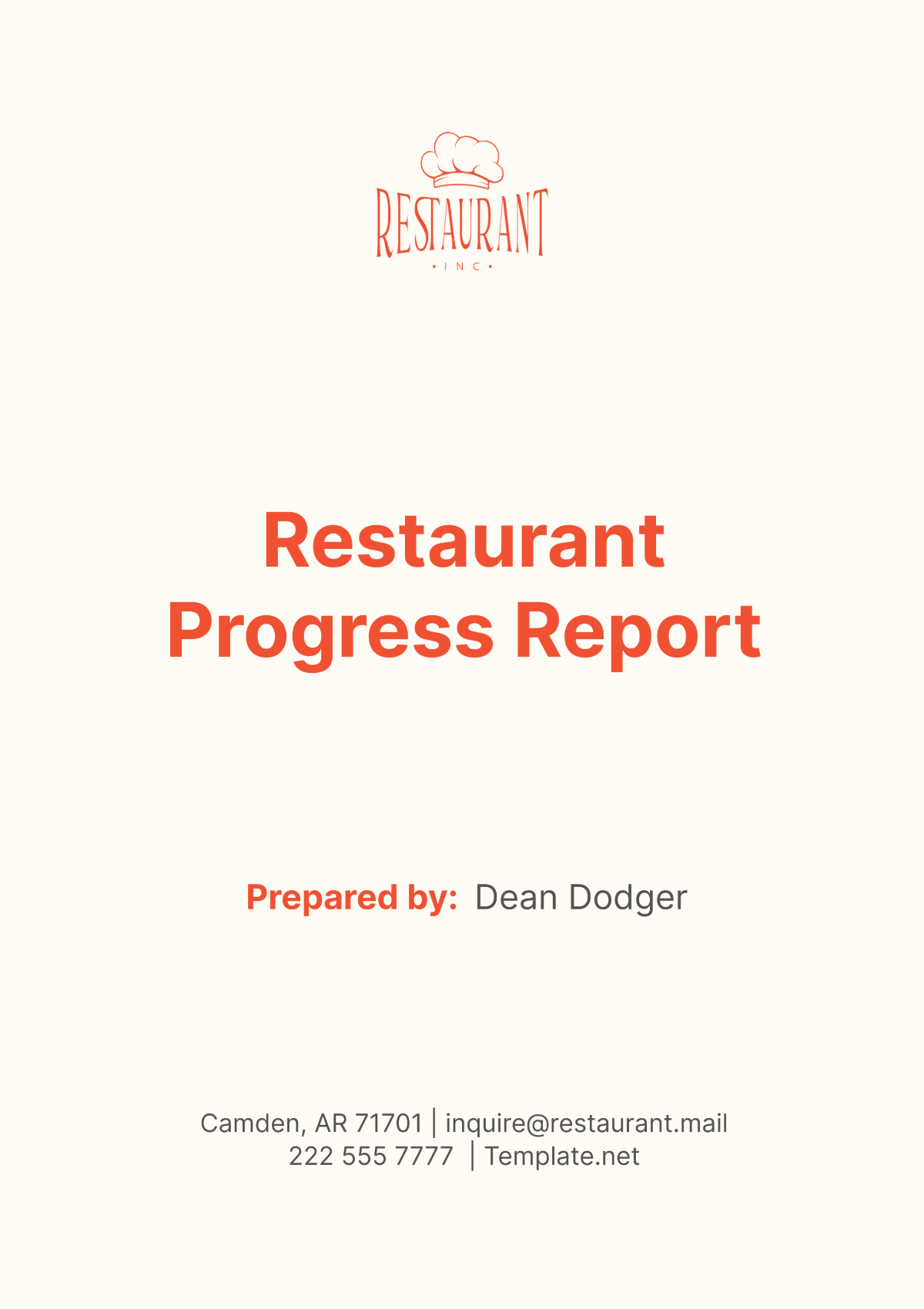
I. Executive Summary
This progress report provides a detailed overview of [YOUR COMPANY NAME]'s performance over the past year, highlighting key financial metrics, customer insights, and operational efficiency. The purpose of this report is to assess our achievements, identify areas for improvement, and set the course for future strategies that align with our business objectives. Our analysis combines data from various sectors of our operations to offer a holistic view of our progress and position in the market.
Key Metrics Overview:
Annual Revenue: $1,600,000
Gross Profit Margin: 25%
Customer Satisfaction Index: 90%
These metrics are crucial for understanding our business health and customer satisfaction level, forming the foundation of our strategic decisions moving forward.
II. Financial Performance
Financial Health Snapshot
Our financial health is a vital aspect of our operational success, reflecting our ability to manage resources effectively while maximizing profitability. This section outlines our key financial metrics for the year, providing a snapshot of our overall economic performance.
Table 1: Key Financial Figures for [YEAR]
Description | Amount ($) |
|---|---|
Total Revenue | $1,600,000 |
Total Expenses | $1,200,000 |
Net Profit | $400,000 |
The figures in Table 1 demonstrate a robust financial position with a solid net profit driven by effective cost management and strong revenue streams. Our financial strategies have focused on optimizing both revenue generation and expense control, which is reflected in the healthy profit margin.
Revenue Streams Breakdown
Diversifying our revenue streams has been a strategic priority to ensure financial stability and foster growth. We have segmented our revenue into different service types to analyze the performance of each and adapt our strategies accordingly.
Table 2: Revenue Breakdown by Service Type
Service Type | Revenue ($) | Percentage of Total Revenue |
|---|---|---|
In-House Dining | $1,000,000 | 62.5% |
Takeaway Services | $400,000 | 25% |
Delivery Services | $200,000 | 12.5% |
Table 2 illustrates how our revenue is distributed across various service offerings. In-house dining remains our most significant source of revenue, while takeaway and delivery services represent vital components of our revenue model, highlighting customer preferences and market trends.
III. Customer Insights
Understanding our customers is crucial for tailoring our services to meet their needs and exceed their expectations. This section delves into the various feedback mechanisms we employ to gather valuable insights from our patrons, which help us refine our offerings and improve customer satisfaction.
Customer Feedback Overview
We actively gather feedback across multiple channels to ensure we capture a broad spectrum of customer experiences and opinions. This data is essential for ongoing service improvements and menu adaptations.
Table 3: Customer Feedback Distribution for [YEAR]
Source | Responses |
|---|---|
Digital Reviews | 2,200 |
Comment Cards | 1,800 |
Social Media | 2,500 |
Table 3 shows the distribution of feedback received from various channels, indicating high levels of engagement. This extensive feedback collection helps us stay responsive to our customers’ needs and preferences.
Feedback Analysis
Analyzing customer feedback is a key process in our quality assurance and customer service enhancement strategies. We monitor satisfaction through ratings and indexes derived from customer interactions.
Table 4: Customer Satisfaction Metrics for [YEAR]
Satisfaction Metric | Value |
|---|---|
Average Rating | 4.6 |
Customer Satisfaction Index | 90% |
Table 4 highlights our success in maintaining a high customer satisfaction index. An average rating of 4.6 is indicative of our commitment to excellence in service and culinary offerings, reflecting positive customer experiences and satisfaction with our restaurant.
IV. Operational Efficiency
Operational efficiency is critical for maintaining high service standards and ensuring customer satisfaction. This section evaluates our performance in terms of process optimization and workforce effectiveness over the past year, which directly impacts our service delivery and overall business health.
Operational Performance Metrics
Efficiency within our operations is crucial for our success. The metrics we monitor help us gauge the effectiveness of our processes and identify areas for improvement.
Table 5: Operational Performance Metrics for [YEAR]
Metric | Annual Average |
|---|---|
Meal Preparation Time | 8 minutes |
Staff Attendance Rate | 98% |
Customer Service Response Time | 2 minutes |
Table 5 provides a snapshot of our key operational metrics. Our focus on reducing meal preparation time and improving response rates to customer inquiries demonstrates our commitment to operational excellence. The high staff attendance rate indicates strong workforce management and employee satisfaction.
Process Improvements
This year, we have implemented several strategic initiatives to enhance our operational efficiency. These include upgrading kitchen equipment, streamlining our meal preparation processes, and enhancing our staff training programs. These improvements have contributed to the reduction in meal preparation times and increased the overall efficiency of our services.
V. Marketing Achievements
Effective marketing is essential for promoting our brand, attracting new customers, and retaining existing ones. This section details our marketing strategies and evaluates their effectiveness in terms of reach, engagement, and conversion rates.
Marketing Campaigns Effectiveness
Our marketing campaigns are designed to maximize reach and foster engagement with our target audience. We measure the success of these campaigns through several key metrics.
Table 6: Marketing Campaigns Effectiveness for [YEAR]
Campaign Type | Reach | Engagement | Conversion Rate |
|---|---|---|---|
Social Media Ads | 300,000 impressions | 35,000 clicks | 11.7% |
Email Marketing | 60,000 subscribers | 24,000 opens | 20% |
Local Event Sponsorships | 4,000 attendees | 2,000 interactions | 30% |
Table 6 outlines the reach and impact of our various marketing campaigns. The high engagement and conversion rates reflect the effectiveness of our marketing strategies, particularly in digital and event marketing, which have significantly contributed to our business growth.
Promotional Impact
We have executed several promotions throughout the year to increase sales and enhance customer loyalty. These promotions are carefully evaluated for their impact on sales and customer engagement.
Table 7: Impact of Promotional Activities in [YEAR]
Promotion | Discount Offered | Increase in Sales |
|---|---|---|
Seasonal Discounts | 20% off | 35% |
Loyalty Program Enhancements | N/A | 40% increase in memberships |
Menu Launch Specials | 15% off new items | 20% |
Table 7 highlights the success of our promotional strategies. Seasonal discounts and special promotions for new menu items have driven substantial increases in sales, while enhancements to our loyalty program have significantly boosted membership numbers, demonstrating effective customer retention strategies.
VI. Conclusion and Future Outlook
Reflecting on the past year, [YOUR COMPANY NAME] has achieved notable success across multiple aspects of our operations. We have seen strong financial performance, high customer satisfaction, significant operational improvements, and effective marketing campaigns. These achievements underscore our commitment to excellence and innovation in the restaurant industry.
Year-End Summary
The efforts and strategies implemented throughout the year have positioned us well for continued growth and improvement.
Table 8: Year-End Performance Summary
Performance Indicator | Value |
|---|---|
Revenue Growth | 10% increase |
Customer Satisfaction Growth | 5% increase |
Operational Efficiency Gain | 8% improvement |
Table 8 summarizes our key performance indicators, reflecting substantial growth in revenue and customer satisfaction, along with improvements in operational efficiency.
Recommendations for the Next Year
Based on our achievements and the insights gained from our performance analysis, we recommend the following strategies for the next year:
Expand Digital Marketing Initiatives: Further invest in digital marketing to enhance reach and engagement, particularly through social media and targeted email campaigns.
Enhance Customer Experience: Continue to refine customer service practices and menu offerings to exceed customer expectations and further increase the satisfaction index.
Optimize Operational Processes: Implement advanced technologies and training programs to boost operational efficiency and reduce service times.
Sustainability Initiatives: Develop sustainability practices in sourcing, waste management, and energy usage to appeal to environmentally conscious consumers.
Immediate Actions
Launch of New Menu Items: Introduce a series of new, innovative dishes by Q2 to attract more customers and provide fresh dining options.
Upgrade Customer Feedback Systems: Enhance real-time feedback mechanisms on digital platforms by Q3 to ensure immediate responsiveness to customer needs.
Staff Development Programs: Initiate comprehensive training programs focused on customer service excellence and operational efficiency starting Q1.
As we look ahead, [YOUR COMPANY NAME] is well-positioned to continue its growth trajectory and further establish its reputation as a leader in the restaurant industry. Our focus will remain on delivering exceptional dining experiences, maintaining financial health, and adapting to the evolving needs of our customers.
- 100% Customizable, free editor
- Access 1 Million+ Templates, photo’s & graphics
- Download or share as a template
- Click and replace photos, graphics, text, backgrounds
- Resize, crop, AI write & more
- Access advanced editor
Track your restaurant's journey to success with Template.net's Restaurant Progress Report Template. Document milestones, challenges, and achievements with clarity and precision. With our AI editor tool, customization is effortless, allowing you to tailor the report to suit your restaurant's unique goals and objectives. Stay informed, make data-driven decisions, and drive progress with confidence using Template.net.
You may also like
- Sales Report
- Daily Report
- Project Report
- Business Report
- Weekly Report
- Incident Report
- Annual Report
- Report Layout
- Report Design
- Progress Report
- Marketing Report
- Company Report
- Monthly Report
- Audit Report
- Status Report
- School Report
- Reports Hr
- Management Report
- Project Status Report
- Handover Report
- Health And Safety Report
- Restaurant Report
- Construction Report
- Research Report
- Evaluation Report
- Investigation Report
- Employee Report
- Advertising Report
- Weekly Status Report
- Project Management Report
- Finance Report
- Service Report
- Technical Report
- Meeting Report
- Quarterly Report
- Inspection Report
- Medical Report
- Test Report
- Summary Report
- Inventory Report
- Valuation Report
- Operations Report
- Payroll Report
- Training Report
- Job Report
- Case Report
- Performance Report
- Board Report
- Internal Audit Report
- Student Report
- Monthly Management Report
- Small Business Report
- Accident Report
- Call Center Report
- Activity Report
- IT and Software Report
- Internship Report
- Visit Report
- Product Report
- Book Report
- Property Report
- Recruitment Report
- University Report
- Event Report
- SEO Report
- Conference Report
- Narrative Report
- Nursing Home Report
- Preschool Report
- Call Report
- Customer Report
- Employee Incident Report
- Accomplishment Report
- Social Media Report
- Work From Home Report
- Security Report
- Damage Report
- Quality Report
- Internal Report
- Nurse Report
- Real Estate Report
- Hotel Report
- Equipment Report
- Credit Report
- Field Report
- Non Profit Report
- Maintenance Report
- News Report
- Survey Report
- Executive Report
- Law Firm Report
- Advertising Agency Report
- Interior Design Report
- Travel Agency Report
- Stock Report
- Salon Report
- Bug Report
- Workplace Report
- Action Report
- Investor Report
- Cleaning Services Report
- Consulting Report
- Freelancer Report
- Site Visit Report
- Trip Report
- Classroom Observation Report
- Vehicle Report
- Final Report
- Software Report
